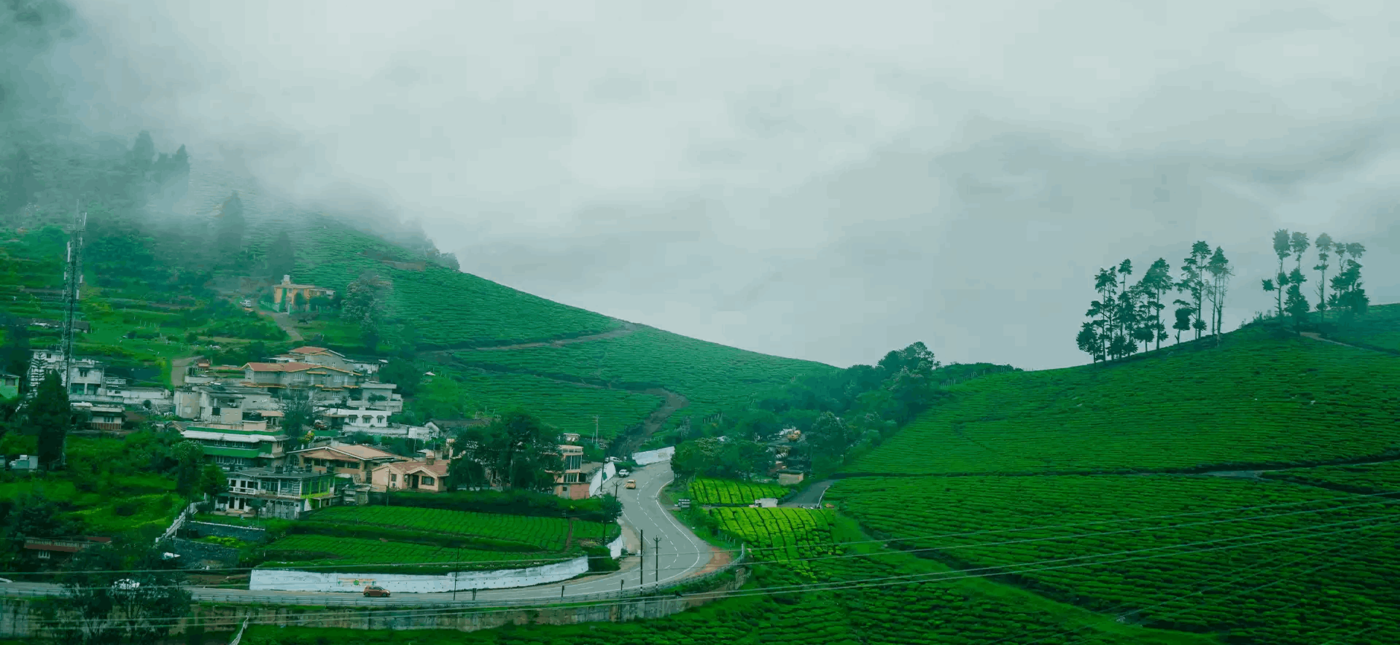Nestled in the Nilgiri Hills of Tamil Nadu, India, Ooty, officially known as Udhagamandalam, is renowned for its breathtaking beauty and serene climate. Often referred to as the “Queen of Hill Stations,” Ooty has long been a favorite destination for those seeking respite from the sweltering heat of the Indian plains. With its lush greenery, colonial charm, and pleasant weather, Ooty offers a unique blend of nature and heritage. This extensive guide provides a detailed exploration of Ooty, covering its history, geography, cultural significance, attractions, activities, and practical travel information.
Geographic and Climate Overview of Ooty
1. Geographic Location
Ooty is located in the Nilgiri Hills, which are part of the Western Ghats mountain range in southern India. Positioned at an elevation of approximately 2,240 meters (7,350 feet) above sea level, Ooty is surrounded by verdant hills, rolling tea plantations, and picturesque lakes. The Nilgiri Hills, known for their unique biodiversity, provide a stunning backdrop to the town.
Key Geographic Features:
- Nilgiri Mountain Range: The hills are characterized by their unique vegetation, including shola forests, grasslands, and eucalyptus groves.
- Ooty Lake: An artificial lake created by the British, providing recreational activities and picturesque views.
- Doddabetta Peak: The highest point in the Nilgiris, offering panoramic views of the surrounding landscape.
2. Ooty Climate
Ooty experiences a subtropical highland climate, which means that the weather is generally mild throughout the year, with distinct seasonal variations.
Seasons:
- Summer (March to June): Temperatures range from 15°C to 20°C (59°F to 68°F), making it a pleasant time for outdoor activities and sightseeing.
- Monsoon (June to September): The monsoon season brings moderate to heavy rainfall, rejuvenating the lush greenery of the region. The average annual rainfall is around 1,500 mm (59 inches). While the rain enhances the landscape, it can also lead to landslides and travel disruptions.
- Winter (October to February): Winter temperatures range from 5°C to 15°C (41°F to 59°F). The weather is cool and crisp, making it a popular time for tourists. Frost can occasionally form in the early mornings.

Historical Background of Ooty
1. Early History
The history of Ooty dates back to ancient times, with evidence of indigenous tribes inhabiting the region. The Nilgiris were known to several tribal communities, including the Todas, Badagas, and Kurumbas. These tribes had their own distinct cultures and practices, and their influence is still evident in the local traditions of Ooty.
Indigenous Tribes:
- Todas: Known for their pastoral lifestyle and traditional Toda huts. They have a unique culture and are recognized for their distinctive rituals and ceremonies.
- Badagas: Another prominent community in the Nilgiris, known for their vibrant cultural practices, including traditional dance forms and festivals.
- Kurumbas: Indigenous to the forests of the Nilgiris, the Kurumbas are known for their knowledge of medicinal plants and forest resources.
2. Colonial Era of Ooty
The colonial history of Ooty began in the early 19th century when the British East India Company established it as a summer retreat. The British found Ooty’s cool climate and scenic beauty an ideal escape from the heat of the Indian plains.
Development and Influence:
- Establishment: Ooty was officially declared a hill station in 1821. The British began developing infrastructure, including roads, colonial-style buildings, and botanical gardens.
- Tea Plantations: The British introduced tea cultivation to the Nilgiris, and the region’s tea estates became an important part of its economy.
- Nilgiri Mountain Railway: The construction of the Nilgiri Mountain Railway in the 19th century was a significant achievement, connecting Ooty to Mettupalayam and enhancing its accessibility.
3. Post-Independence Era
After India gained independence in 1947, Ooty continued to thrive as a popular tourist destination. The town has maintained its colonial charm while evolving to meet modern needs. Today, Ooty is a vibrant hill station with a blend of historical significance and contemporary amenities.

Cultural Heritage of Ooty
1. Local Communities
Ooty’s cultural heritage is shaped by its diverse population, including indigenous tribes and various other communities. The town’s cultural landscape reflects a blend of traditional practices and colonial influences.
Indigenous Tribes:
- Toda Tribe: Known for their distinctive customs, Toda people are recognized for their traditional attire, rituals, and unique architecture.
- Badaga Community: Badagas have a rich cultural heritage, including traditional music, dance, and festivals that contribute to the cultural fabric of Ooty.
- Kurumba Tribe: The Kurumbas are known for their knowledge of herbal medicine and traditional practices.
2. Festivals and Celebrations
Ooty hosts a variety of festivals and cultural events throughout the year, reflecting its rich heritage and diverse communities.
Notable Festivals:
- Dussehra: Celebrated with great enthusiasm, Dussehra marks the victory of good over evil. The festival includes traditional dance, music, and cultural performances.
- Pongal: A major Tamil festival celebrated in January, marking the harvest season. Pongal involves cooking a special dish called Pongal, decorated with sugarcane, and participating in traditional games and rituals.
- Flower Show: Held annually at the Botanical Gardens, the Flower Show showcases a stunning array of flowers, plants, and floral arrangements, drawing visitors from across the country.

Attractions Ooty tourist places
1. Botanical Gardens
The Ooty Botanical Gardens, established in 1848, are one of the most popular attractions in the town. Spread over 55 acres, the gardens feature a diverse collection of plants, including exotic species, medicinal herbs, and ornamental plants.
Key Features:
- Fern House: Showcases a variety of ferns and mosses.
- Rose Garden: Displays a wide range of rose varieties.
- Lake View: Offers a picturesque view of Ooty Lake.
2. Ooty Lake
Ooty Lake is an artificial lake created by the British in the 19th century. It is a popular spot for boating and leisurely walks.
Activities:
- Boating: Paddle boats and rowboats are available for hire.
- Picnicking: The lake’s surroundings are ideal for picnics and relaxation.
3. Nilgiri Mountain Railway
The Nilgiri Mountain Railway, a UNESCO World Heritage Site, is a historical steam train that runs between Mettupalayam and Ooty. The journey offers breathtaking views of the Nilgiri Hills and tea plantations.
Route and Features:
- Mettupalayam to Ooty: The train covers a distance of approximately 46 kilometers (29 miles) and passes through several tunnels and bridges.
- Scenic Journey: The route offers stunning views of the hills, forests, and valleys, providing a unique travel experience.
4. Doddabetta Peak
Doddabetta Peak is the highest point in the Nilgiri Hills, standing at 2,637 meters (8,650 feet) above sea level. The peak offers panoramic views of the surrounding landscape and is a popular spot for trekking and sightseeing.
Activities:
- Viewpoint: The peak has a designated viewpoint for capturing scenic photographs.
- Trekking: Various trails lead to the summit, offering a rewarding experience for hikers.
5. Tea Estates
Ooty is renowned for its tea plantations, which produce some of the finest teas in India. Visitors can explore the tea estates, learn about tea production, and sample different varieties.
Tea Museums and Estates:
- Glenmorgan Tea Factory: Offers guided tours and tea-tasting sessions.
- Toda Tea Estate: Provides insights into traditional tea cultivation practices.
6. Ooty Rose Garden
The Rose Garden in Ooty is one of the largest rose gardens in India, featuring thousands of rose varieties in various colors and shapes. The garden is a visual treat and a popular destination for flower enthusiasts.
Highlights:
- Rose Varieties: Includes hybrid teas, floribundas, and miniature roses.
- Seasonal Blooms: The garden is at its best during the blooming season.
7. St. Stephen’s Church
St. Stephen’s Church, built in 1829, is one of the oldest churches in Ooty. The church’s colonial architecture and serene surroundings make it a notable historical site.
Features:
- Architecture: The church features Gothic-style architecture with beautiful stained-glass windows.
- History: It is an important landmark reflecting the colonial history of Ooty.

Activities and Experiences in ooty hill station
1. Trekking and Hiking
Ooty offers numerous trekking and hiking opportunities for adventure enthusiasts. The surrounding hills and forests provide a range of trails suitable for various skill levels.
Popular Trails:
- Trekking to Doddabetta Peak: A challenging trek leading to the highest point in the Nilgiris.
- Glenmorgan Trek: A scenic trek offering views of tea plantations and forests.
2. Boating and Water Activities
Boating on Ooty Lake
is a popular activity, providing a relaxing way to enjoy the picturesque surroundings.
Boating Options:
- Paddle Boats: Ideal for a leisurely experience on the lake.
- Row Boats: Available for a more traditional boating experience.
3. Shopping and Souvenirs of Ooty
Ooty has a variety of shopping options, from local markets to boutiques offering unique souvenirs.
Shopping Highlights:
- Charing Cross Market: Offers local products, including handicrafts and tea.
- Ooty Main Bazaar: A bustling market where you can find traditional clothing, artifacts, and spices.
Souvenirs:
- Tea: Buy packets of Nilgiri tea as souvenirs or gifts.
- Handicrafts: Look for locally made crafts and artifacts that reflect the region’s cultural heritage.
4. Local Cuisine
Ooty’s cuisine reflects its diverse cultural influences and includes a variety of South Indian and continental dishes.
Must-Try Dishes:
- Vadas and Idlis: Popular South Indian snacks served with chutneys and sambar.
- Nilgiri Tea: Sample the locally grown tea, known for its distinct flavor.
- Fresh Strawberries: Ooty is known for its strawberry farms, and fresh strawberries are a seasonal delight.

Ooty Travel Tips
1. Best Time to Visit Ooty
The ideal time to visit Ooty is between March and June and from September to November. During these months, the weather is pleasant, and the town is accessible without heavy rainfall or extreme cold.
2. Getting There
flights to ooty By Air:
The nearest airport to Ooty is Coimbatore International Airport, located approximately 85 kilometers (53 miles) away. From the airport, you can hire a taxi or take a bus to reach Ooty.
By Train:
The Nilgiri Mountain Railway connects Ooty to Mettupalayam, which is accessible by train from major cities like Chennai and Bangalore. The train journey offers a scenic experience through the Nilgiri Hills.
By Road:
Ooty is well-connected by road, with regular bus services from cities like Chennai, Bangalore, and Coimbatore. The road journey offers beautiful views of the hills and forests.
3. Accommodation
Ooty offers a range of accommodation options, from luxury resorts to budget hotels and homestays. Some popular choices include:
Ooty Luxury Resorts:
- Savoy Hotel: A historic property offering colonial charm and modern amenities.
- Taj Savoy Hotel: A luxurious resort with elegant rooms and excellent services.
Budget Hotels:
- Hotel Lakeview: A budget-friendly option with a central location and basic amenities.
- Hotel Darshan: Offers comfortable accommodation at affordable rates.
Homestays:
- Misty Meadows: Provides a cozy stay with a homely atmosphere and personalized service.
- The Whistling Pines: Offers a serene retreat amidst nature with comfortable facilities.
4. Health and Safety
Health Precautions:
- Altitude Sickness: While Ooty’s altitude is relatively moderate, it’s advisable to stay hydrated and avoid strenuous activities until you acclimate.
- Travel Insurance: Consider purchasing travel insurance to cover unforeseen circumstances.
Safety Tips:
- Weather Conditions: Be prepared for sudden changes in weather. Carry warm clothing, rain gear, and sun protection.
- Road Safety: Road conditions can be challenging, especially in the monsoon. Travel with a reliable vehicle and a knowledgeable driver.

Conclusion
Ooty, with its stunning landscapes, pleasant climate, and rich cultural heritage, stands as one of India’s most cherished hill stations. From its historical significance and colonial charm to its vibrant local traditions and diverse attractions, Ooty offers something for every traveler. Whether you seek relaxation amidst nature, adventurous activities, or a glimpse into the region’s cultural tapestry, Ooty promises an unforgettable experience. As you explore this enchanting hill station, you will find that its natural beauty, historical allure, and warm hospitality make it a destination worth revisiting.
By understanding the unique aspects of Ooty and preparing accordingly, you can make the most of your visit to this “Queen of Hill Stations” and create lasting memories in one of India’s most picturesque locations.
